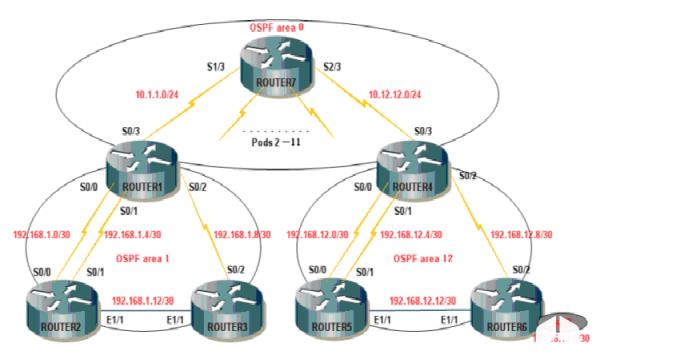OSPF(Open Shortest Path First,开放式最短路径优先)是一个内部网关协议(Interior Gateway Protocol,简称IGP),用于在单一自治系统(Autonompus System,AS)内决策路由。是对链路状态路由协议的一种实现,隶属内部网络协议(IGP),故运作于自治系统内部。OSPF通过路由器之间通告网络接口的状态来建立链路状态数据库,生成最短路径树,每个OSPF路由器使用这些最短路径构造路由表。
作为一种链路状态的路由协议,OSPF将链路状态广播数据包LSA(Link State Advertisement)传送给在某一区域内的所有路由器,这一点与距离矢量路由协议不同。运行距离矢量路由协议的路由器是将部分或全部的路由表传递给与其相邻的路由器。
1、多区域OSPF的好处
单区域OSPF中每台路由器都需要维护的路由表越来越大,单区域内路由无法汇总,;收到的LSA通告太多;内部动荡会引起全网路由器的完全SPF计算;资源消耗过多,性能下降,影响数据转发。而多区域OSPF能够减少LSDB的大小,节约带宽;提高路由的效率:缩减部分路由器的OSPF路由条目,降低路由收敛的复杂度,对某些特定的LSA,可以在区域边界上,实现汇总/过滤/控制,而实现全网互通;提高网络的稳定性:当某个区域的某条路由出现抖动时,可以减少受影响的波及面。
2、区域ID
区域ID长32bit,其表示范围为0-65535。当设置arer 0时,其区域ID为0.0.0.0;当设置区域area 5时,其区域ID为0.0.0.5;当设置区域area271时,其区域ID为0.0.1.15。
3、区域设置原则
1) 作为骨干区域的area0必须存在;
2) 所有区域,即使是端区,也必须和骨干区域相连;
3) 如果存在多个骨干区域,那么它们必须连续(逻辑上);什么情况使用多骨干区域?好处是?Area 0只有一个是最好的,当有多个的话就是骨干区域分裂了,做使用虚链路连接
4) 虚链路只能作为一种应急的临时策略。
4、区域类型
1) 骨干区域:负责分发非骨干区域之间的路由选择信息。
2)普通区域:除骨干区域外,所有为特殊设置的区域。
3)端区(stub):
命令:(config-router)#area area-id stub
作用:可以较少区域内LSDB的规模,降低区域内部路由选择表的大小,并较少区域内部路由器对存储器的需求。
特点:
1.区域内所有路由器都应该配置成端路由器。因为端区的路由器通过hello包中的标志位识别区域类型,如果路由器不能达成一致,则不能形成邻居。
2.其ABR阻止类型LAS4、LSA5。即端区内没有到达外部的路由,但有到达其他区域的路由。
3.从端区去外部是基于缺省路由的,而且这条缺省路由是自动添加的。
4)完全端区(total stub):完全端区为Cisco私有的。
命令:(config-router)#area area-id stub no-summary
作用:减少OSPF数据库和路由表的规模。
特点:
1.每个路由器都要配置成完全端区;
2.只存在区域内部的路由,拒绝了类型LSA3、LSA4、LSA5;
3.自动生成缺省路由。(通过特殊的LSA3进去的)
5)非完全端区(no-so-stubbly-area):
作用:在端区的基础上允许引进非直连的外部路由选择信息。
特点:LSA7会被NSSA的ABR路由器转换成LAS5在整个AS支持LSA5的区域内flooding;
类型:
1.普通NSSA:
命令:(config-router)#area area-id nssa
特点:缺省路由不是自动生成的;拒绝了类型LSA4、LSA5。
2.完全NSSA:
命令:(config-router)#area area-id nssa o-summary
特点:自动生成缺省路由;拒绝了类型LSA3、LSA4、LSA5。
NSSA使用环境:当区域位于ASBR和ABR之间,且ASBR连接到非OSPF协议网络,ABR连接到OSPF网络骨干区域时就使用NSSA.。想阻止来自其它区域的外部路由,但本区域又想重发布外布的路由。
5、实验

实验拓扑及网络规划:如上图
任务1.按照实验要求连接拓扑。
任务2.完成所有网络基本IP配置【环回除外】,并测试网络联通性。
任务3.启动骨干区域AREA 0的OSPF进程。
实验操作过程及配置说明:
任务1.按照实验要求连接拓扑。

任务2.完成所有网络基本IP配置【环回除外】,并测试网络联通性。
r1#show ip int bri
Interface IP-Address OK? Method Status Protocol
Serial0/0 192.168.1.1 YES manual up up
Serial0/1 192.168.1.5 YES manual up up
Serial0/2 192.168.1.9 YES manual up up
Serial0/3 10.1.1.2 YES manual up up
r2#show ip int bri
Interface IP-Address OK? Method Status Protocol
Serial0/0 192.168.1.2 YES manual up up
Serial0/1 192.168.1.6 YES manual up up
Serial0/2 unassigned YES unset administratively down down
Serial0/3 unassigned YES unset administratively down down
Ethernet1/0 unassigned YES unset administratively down down
Ethernet1/1 192.168.1.13 YES manual up up
Ethernet1/2 unassigned YES unset administratively down down
r3#show ip int bri
Interface IP-Address OK? Method Status Protocol
Serial0/0 unassigned YES unset administratively down down
Serial0/1 unassigned YES unset administratively down down
Serial0/2 192.168.1.10 YES manual up up
Serial0/3 unassigned YES unset administratively down down
Ethernet1/0 unassigned YES unset administratively down down
Ethernet1/1 192.168.1.14 YES manual up up
Ethernet1/2 unassigned YES unset administratively down down
Ethernet1/3 unassigned YES unset administratively down down
r4#show ip int bri
Interface IP-Address OK? Method Status Protocol
Serial0/0 192.168.12.1 YES manual up up
Serial0/1 192.168.12.5 YES manual up up
Serial0/2 192.168.12.9 YES manual up up
Serial0/3 10.12.12.2 YES manual up up
r5#show ip int bri
Interface IP-Address OK? Method Status Protocol
Serial0/0 192.168.12.2 YES manual up up
Serial0/1 192.168.12.6 YES manual up up
Serial0/2 unassigned YES unset administratively down down
Serial0/3 unassigned YES unset administratively down down
Ethernet1/0 unassigned YES unset administratively down down
Ethernet1/1 192.168.12.13 YES manual up up
Ethernet1/2 unassigned YES unset administratively down down
Ethernet1/3 unassigned YES unset administratively down down
r6#show ip int bri
Interface IP-Address OK? Method Status Protocol
Serial0/0 unassigned YES unset administratively down down
Serial0/1 unassigned YES unset administratively down down
Serial0/2 192.168.12.10 YES manual up up
Serial0/3 unassigned YES unset administratively down down
Ethernet1/0 unassigned YES unset administratively down down
Ethernet1/1 192.168.12.14 YES manual up up
Ethernet1/2 unassigned YES unset administratively down down
Ethernet1/3 unassigned YES unset administratively down down
r7#show ip int bri
Interface IP-Address OK? Method Status Protocol
Serial0/0 unassigned YES unset administratively down down
Serial0/1 10.1.1.1 YES manual up up
Serial0/2 10.12.12.1 YES manual up up
Serial0/3 unassigned YES unset administratively down down
任务3.启动骨干区域AREA 0的OSPF进程。
r7(config)#router ospf 10
r7(config-router)#router-id 7.7.7.7
r7(config-router)#network 10.1.1.1 0.0.0.0 a 0
r7(config-router)#network 10.12.12.1 0.0.0.0 a 0
r7(config-router)#end
r1(config)#router ospf 10
r1(config-router)#router-id 1.1.1.1
r1(config-router)#network 10.1.1.2 0.0.0.0 a 0
r1(config-router)#end
r4(config)#router ospf 10
r4(config-router)#router-id 4.4.4.4
r4(config-router)#network 10.12.12.2 0.0.0.0 a 0
r4(config-router)#end
本文对多区域OSPF做了简单的介绍,OSPF协议采用路由器间建立和维护邻接关系,维护链路状态信息数据库,采用最短生成树算法,避免了路由自环。同时,又采用了一些特殊的机制,保证了它在大规模网络中的可用性。
短信预约-IT技能 免费直播动态提醒
短信预约提醒成功
OSPF多区域以及配置实例
免责声明:
① 本站未注明“稿件来源”的信息均来自网络整理。其文字、图片和音视频稿件的所属权归原作者所有。本站收集整理出于非商业性的教育和科研之目的,并不意味着本站赞同其观点或证实其内容的真实性。仅作为临时的测试数据,供内部测试之用。本站并未授权任何人以任何方式主动获取本站任何信息。
② 本站未注明“稿件来源”的临时测试数据将在测试完成后最终做删除处理。有问题或投稿请发送至: 邮箱/279061341@qq.com QQ/279061341
软考中级精品资料免费领
历年真题答案解析
备考技巧名师总结
高频考点精准押题
- 资料下载
- 历年真题
193.9 KB下载数265
191.63 KB下载数245
143.91 KB下载数1148
183.71 KB下载数642
644.84 KB下载数2756
相关文章
发现更多好内容- JavaWeb 中 contextConfigLocation 属性该如何使用?(JavaWeb中contextConfigLocation属性怎么用)
- Docker中Redis配置指南
- “IT百科”进阶学习之“虚拟化技术全攻略”
- 如何利用 Java Thread.join 实现线程间的通信?(Java Thread.join如何处理线程间的通信)
- 员工最害怕被裁员的10家科技公司,看看都有谁?
- 告白成不成心里没数,系统扛不扛得住还没数吗?!
- 【JavaScript】ES6 中class定义类
- Nginx为uwsgi服务做缓存的配置方法
- Java 依赖注入的好处有哪些?(java 依赖注入有哪些好处)
- 2019年区块链将发生这十件大事
猜你喜欢
AI推送时光机OSPF多区域以及配置实例

考试报考2024-04-18
ospf多区域原理和配置
考试报考2023-09-11
Tomcat多实例部署及配置原理
考试报考2024-04-02
MySQL多实例创建及配置的步骤
考试报考2024-04-02
什么是mysql多实例及如何配置
考试报考2024-04-02
SpringBoot多环境配置及配置文件分类实例详解
考试报考2022-11-13
华为交换机STP以及基本实例配置

考试报考2024-04-18
MySQL多实例配置文件及启动文件
考试报考2024-04-02
Apache中通过配置http.conf绑定多个域名以及二级域名的方法
考试报考2022-06-03
MySQL的多实例介绍及配置是怎样的
考试报考2024-04-02
Vue3axios配置以及cookie的使用方法实例演示
考试报考2023-02-18
MySQL5.7多实例安装及开机启动配置(亲测)

考试报考2016-07-12
Vue如何实现多页面配置以及打包方式
考试报考2022-11-13
MySQL多实例数据库的安装及配置方法
考试报考2024-04-02
Mysql 8.0解压版下载安装以及配置的实例教程
考试报考2024-04-02
咦!没有更多了?去看看其它编程学习网 内容吧





